[English] 日本語
 Yorodumi
Yorodumi- PDB-3p4n: Crystal Structure of H2-Kb in complex with the NP205-PV epitope Y... -
+ Open data
Open data
- Basic information
Basic information
| Entry | Database: PDB / ID: 3p4n | ||||||
|---|---|---|---|---|---|---|---|
| Title | Crystal Structure of H2-Kb in complex with the NP205-PV epitope YTVKFPNM, an 8-mer peptide from PV | ||||||
 Components Components |
| ||||||
 Keywords Keywords | IMMUNE SYSTEM / H2-Kb / PV / LCMV / TCR / T cell / MHC / viral escape | ||||||
| Function / homology |  Function and homology information Function and homology informationsymbiont-mediated suppression of host cytoplasmic pattern recognition receptor signaling pathway via inhibition of IKBKE activity / RNA-templated viral transcription / negative stranded viral RNA replication / Endosomal/Vacuolar pathway / DAP12 interactions / Antigen Presentation: Folding, assembly and peptide loading of class I MHC / ER-Phagosome pathway / DAP12 signaling / Immunoregulatory interactions between a Lymphoid and a non-Lymphoid cell / helical viral capsid ...symbiont-mediated suppression of host cytoplasmic pattern recognition receptor signaling pathway via inhibition of IKBKE activity / RNA-templated viral transcription / negative stranded viral RNA replication / Endosomal/Vacuolar pathway / DAP12 interactions / Antigen Presentation: Folding, assembly and peptide loading of class I MHC / ER-Phagosome pathway / DAP12 signaling / Immunoregulatory interactions between a Lymphoid and a non-Lymphoid cell / helical viral capsid / antigen processing and presentation of exogenous peptide antigen via MHC class I / inner ear development / antigen processing and presentation of endogenous peptide antigen via MHC class I via ER pathway, TAP-dependent / cellular defense response / Neutrophil degranulation / lumenal side of endoplasmic reticulum membrane / cellular response to iron(III) ion / negative regulation of forebrain neuron differentiation / antigen processing and presentation of exogenous protein antigen via MHC class Ib, TAP-dependent / iron ion transport / peptide antigen assembly with MHC class I protein complex / regulation of iron ion transport / regulation of erythrocyte differentiation / HFE-transferrin receptor complex / response to molecule of bacterial origin / MHC class I peptide loading complex / T cell mediated cytotoxicity / positive regulation of T cell cytokine production / antigen processing and presentation of endogenous peptide antigen via MHC class I / MHC class I protein complex / peptide antigen binding / positive regulation of receptor-mediated endocytosis / negative regulation of neurogenesis / cellular response to nicotine / positive regulation of T cell mediated cytotoxicity / multicellular organismal-level iron ion homeostasis / phagocytic vesicle membrane / negative regulation of epithelial cell proliferation / sensory perception of smell / positive regulation of cellular senescence / T cell differentiation in thymus / negative regulation of neuron projection development / protein refolding / viral nucleocapsid / Hydrolases; Acting on ester bonds; Exoribonucleases producing 5'-phosphomonoesters / protein homotetramerization / amyloid fibril formation / intracellular iron ion homeostasis / host cell cytoplasm / learning or memory / hydrolase activity / defense response to bacterium / ribonucleoprotein complex / external side of plasma membrane / structural molecule activity / Golgi apparatus / protein homodimerization activity / extracellular space / RNA binding / metal ion binding / cytosol Similarity search - Function | ||||||
| Biological species |  | ||||||
| Method |  X-RAY DIFFRACTION / X-RAY DIFFRACTION /  SYNCHROTRON / SYNCHROTRON /  MOLECULAR REPLACEMENT / MOLECULAR REPLACEMENT /  molecular replacement / Resolution: 2.5 Å molecular replacement / Resolution: 2.5 Å | ||||||
 Authors Authors | Gras, S. / Guillonneau, C. / Rossjohn, J. | ||||||
 Citation Citation |  Journal: To be Published Journal: To be PublishedTitle: Crystal Structure of H2-Kb in complex with the NP205-PV epitope YTVKFPNM, an 8-mer peptide from PV Authors: Gras, S. / Guillonneau, C. / Rossjohn, J. | ||||||
| History |
|
- Structure visualization
Structure visualization
| Structure viewer | Molecule:  Molmil Molmil Jmol/JSmol Jmol/JSmol |
|---|
- Downloads & links
Downloads & links
- Download
Download
| PDBx/mmCIF format |  3p4n.cif.gz 3p4n.cif.gz | 170.2 KB | Display |  PDBx/mmCIF format PDBx/mmCIF format |
|---|---|---|---|---|
| PDB format |  pdb3p4n.ent.gz pdb3p4n.ent.gz | 134.2 KB | Display |  PDB format PDB format |
| PDBx/mmJSON format |  3p4n.json.gz 3p4n.json.gz | Tree view |  PDBx/mmJSON format PDBx/mmJSON format | |
| Others |  Other downloads Other downloads |
-Validation report
| Summary document |  3p4n_validation.pdf.gz 3p4n_validation.pdf.gz | 467.3 KB | Display |  wwPDB validaton report wwPDB validaton report |
|---|---|---|---|---|
| Full document |  3p4n_full_validation.pdf.gz 3p4n_full_validation.pdf.gz | 488.9 KB | Display | |
| Data in XML |  3p4n_validation.xml.gz 3p4n_validation.xml.gz | 32.4 KB | Display | |
| Data in CIF |  3p4n_validation.cif.gz 3p4n_validation.cif.gz | 44.6 KB | Display | |
| Arichive directory |  https://data.pdbj.org/pub/pdb/validation_reports/p4/3p4n https://data.pdbj.org/pub/pdb/validation_reports/p4/3p4n ftp://data.pdbj.org/pub/pdb/validation_reports/p4/3p4n ftp://data.pdbj.org/pub/pdb/validation_reports/p4/3p4n | HTTPS FTP |
-Related structure data
| Related structure data | 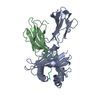 1vacS S: Starting model for refinement |
|---|---|
| Similar structure data |
- Links
Links
- Assembly
Assembly
| Deposited unit | 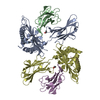
| ||||||||
|---|---|---|---|---|---|---|---|---|---|
| 1 | 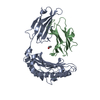
| ||||||||
| 2 | 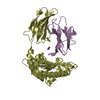
| ||||||||
| Unit cell |
|
- Components
Components
| #1: Protein | Mass: 32102.855 Da / Num. of mol.: 2 / Fragment: Extracellular domain Source method: isolated from a genetically manipulated source Source: (gene. exp.)   #2: Protein | Mass: 11704.359 Da / Num. of mol.: 2 Source method: isolated from a genetically manipulated source Source: (gene. exp.)   #3: Protein/peptide | Mass: 1000.191 Da / Num. of mol.: 2 / Source method: obtained synthetically / Details: Synthetic peptide / References: UniProt: P03541 #4: Chemical | #5: Water | ChemComp-HOH / | |
|---|
-Experimental details
-Experiment
| Experiment | Method:  X-RAY DIFFRACTION / Number of used crystals: 1 X-RAY DIFFRACTION / Number of used crystals: 1 |
|---|
- Sample preparation
Sample preparation
| Crystal | Density Matthews: 2.78 Å3/Da / Density % sol: 55.8 % |
|---|---|
| Crystal grow | Temperature: 277 K / Method: vapor diffusion, hanging drop / pH: 6.5 Details: 0.2M ammonium acetate, 16-24% PEG 3350, 0.1M Na-cacodylate, pH 6.5, vapor diffusion, hanging drop, temperature 277K |
-Data collection
| Diffraction | Mean temperature: 100 K | ||||||||||||||||||||||||||||||||||||||||||||||||||||||||||||||||||||||||||||||||||||||||||||||||||||
|---|---|---|---|---|---|---|---|---|---|---|---|---|---|---|---|---|---|---|---|---|---|---|---|---|---|---|---|---|---|---|---|---|---|---|---|---|---|---|---|---|---|---|---|---|---|---|---|---|---|---|---|---|---|---|---|---|---|---|---|---|---|---|---|---|---|---|---|---|---|---|---|---|---|---|---|---|---|---|---|---|---|---|---|---|---|---|---|---|---|---|---|---|---|---|---|---|---|---|---|---|---|
| Diffraction source | Source:  SYNCHROTRON / Site: SYNCHROTRON / Site:  Australian Synchrotron Australian Synchrotron  / Beamline: MX1 / Wavelength: 0.9 Å / Beamline: MX1 / Wavelength: 0.9 Å | ||||||||||||||||||||||||||||||||||||||||||||||||||||||||||||||||||||||||||||||||||||||||||||||||||||
| Detector | Type: ADSC QUANTUM 210r / Detector: CCD / Date: Jul 20, 2007 | ||||||||||||||||||||||||||||||||||||||||||||||||||||||||||||||||||||||||||||||||||||||||||||||||||||
| Radiation | Protocol: SINGLE WAVELENGTH / Monochromatic (M) / Laue (L): M / Scattering type: x-ray | ||||||||||||||||||||||||||||||||||||||||||||||||||||||||||||||||||||||||||||||||||||||||||||||||||||
| Radiation wavelength | Wavelength: 0.9 Å / Relative weight: 1 | ||||||||||||||||||||||||||||||||||||||||||||||||||||||||||||||||||||||||||||||||||||||||||||||||||||
| Reflection | Resolution: 2.5→100 Å / Num. obs: 32752 / % possible obs: 95.9 % / Observed criterion σ(I): -3 / Biso Wilson estimate: 30.537 Å2 / Rmerge(I) obs: 0.067 / Net I/σ(I): 10.76 | ||||||||||||||||||||||||||||||||||||||||||||||||||||||||||||||||||||||||||||||||||||||||||||||||||||
| Reflection shell | Diffraction-ID: 1
|
-Phasing
| Phasing | Method:  molecular replacement molecular replacement |
|---|
- Processing
Processing
| Software |
| |||||||||||||||||||||||||||||||||||||||||||||||||||||||||||||||||||||||||||||
|---|---|---|---|---|---|---|---|---|---|---|---|---|---|---|---|---|---|---|---|---|---|---|---|---|---|---|---|---|---|---|---|---|---|---|---|---|---|---|---|---|---|---|---|---|---|---|---|---|---|---|---|---|---|---|---|---|---|---|---|---|---|---|---|---|---|---|---|---|---|---|---|---|---|---|---|---|---|---|
| Refinement | Method to determine structure:  MOLECULAR REPLACEMENT MOLECULAR REPLACEMENTStarting model: 1vac Resolution: 2.5→19.917 Å / Occupancy max: 1 / Occupancy min: 1 / SU ML: 0.44 / σ(F): 0.03 / Stereochemistry target values: MLHL
| |||||||||||||||||||||||||||||||||||||||||||||||||||||||||||||||||||||||||||||
| Solvent computation | Shrinkage radii: 0.9 Å / VDW probe radii: 1.11 Å / Solvent model: FLAT BULK SOLVENT MODEL / Bsol: 22.379 Å2 / ksol: 0.322 e/Å3 | |||||||||||||||||||||||||||||||||||||||||||||||||||||||||||||||||||||||||||||
| Displacement parameters | Biso max: 97.74 Å2 / Biso mean: 27.3663 Å2 / Biso min: 8.29 Å2
| |||||||||||||||||||||||||||||||||||||||||||||||||||||||||||||||||||||||||||||
| Refinement step | Cycle: LAST / Resolution: 2.5→19.917 Å
| |||||||||||||||||||||||||||||||||||||||||||||||||||||||||||||||||||||||||||||
| Refine LS restraints |
| |||||||||||||||||||||||||||||||||||||||||||||||||||||||||||||||||||||||||||||
| LS refinement shell | Refine-ID: X-RAY DIFFRACTION / Total num. of bins used: 10
|
 Movie
Movie Controller
Controller


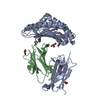
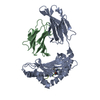
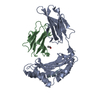
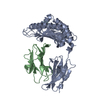



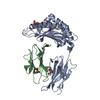

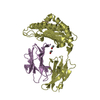
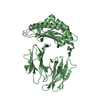

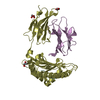
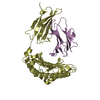


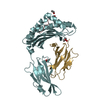
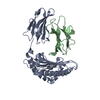
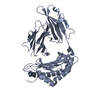
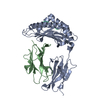
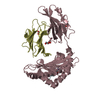
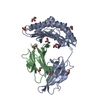




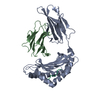
 PDBj
PDBj












